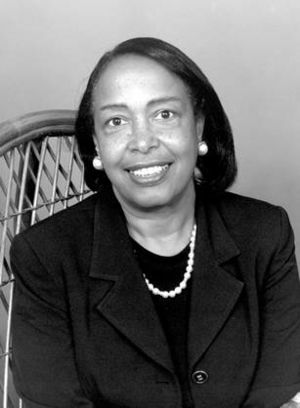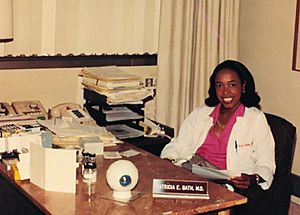Patricia Bath facts for kids
Quick facts for kids
Patricia Era Bath
|
|
|---|---|
 |
|
| Born | November 4, 1942 New York City, U.S.
|
| Died | May 30, 2019 (aged 76) San Francisco, California, U.S.
|
| Alma mater | Hunter College (B.A.) Howard University (M.D.) |
| Occupation | Eye Doctor, inventor, humanitarian |
| Known for | Invention of Laserphaco Probe |
Patricia Era Bath (born November 4, 1942 – died May 30, 2019) was an amazing American eye doctor, inventor, and helper of people. She created a much better way to do laser cataract surgery. Her invention was called the Laserphaco Probe. She received a patent for it in 1986.
Dr. Bath was also a pioneer in many ways. She was the first woman to join the Jules Stein Eye Institute. She was also the first woman to lead a special training program for eye doctors. Plus, she was the first woman chosen for the honorary staff at the UCLA Medical Center.
Contents
Early Life and Education
Patricia Bath was born in 1942 in Harlem, New York. Her parents were Rupert and Gladys Bath.
Her father came from Trinidad. He wrote for newspapers and worked as a merchant seaman. He was also the first Black man to be a motorman for the New York City Subway. He taught her to love different cultures.
Her mother was a descendant of African slaves and Cherokee Native Americans. Patricia's parents always told her to do her best. They strongly supported her education. Her mother even bought her first chemistry set, encouraging her love for science.
When she was in high school, Patricia was already a National Science Foundation scholar. Her research on cancer was even featured on the front page of the New York Times. Patricia and her brother were both very good at science and math at Charles Evans Hughes High School.
Inspired by the doctor Albert Schweitzer, Patricia won a scholarship while in high school. She then did research at Yeshiva University and Harlem Hospital Center. She studied how cancer, nutrition, and stress were connected. During this summer program, she found a math equation that could guess how cancer cells would grow. Her discoveries were so important that they were published in a science paper. They were also shared at a big international meeting in 1960.
In 1960, when she was 18, Patricia won an award from Mademoiselle magazine.
Patricia earned her Bachelor of Arts degree in chemistry from Hunter College in 1964. Then, she moved to Washington, D.C. to attend Howard University College of Medicine. In 1965, she helped start the Student National Medical Association. She became its first woman president.
While at Howard, she won a special award to do research in Belgrade, Yugoslavia in 1967. There, she focused on surgery for children. She met Earl Warren, the chief justice of the U.S. Supreme Court, during the award ceremony. Patricia graduated with honors from Howard University in 1968.
She returned to Harlem and worked as an intern at Harlem Hospital Center. This hospital was connected to Columbia University.
From 1970 to 1973, Patricia trained to be an eye doctor at New York University. She was the first African American to do this.
Career Highlights
After her training, Dr. Bath joined a special program at Columbia University from 1973 to 1974.
She was then asked to help start an eye doctor training program. This was at both the UCLA Jules Stein Eye Institute and Charles R. Drew University.
She began her career in Los Angeles. She became the first woman eye doctor on the faculty at the Jules Stein Eye Institute at UCLA. In 1974, she became the assistant chief of the King-Drew-UCLA Ophthalmology Residency Program. She was made chief in 1983.
At both universities, Dr. Bath became an associate professor. At UCLA, she started the Ophthalmic Assistant Training Program (OATP) in 1978. This program trains people to help prevent blindness by screening eyes and teaching about eye health.
While at UCLA, Dr. Bath created a program to give advanced surgery to blind patients. This program still helps thousands of patients get their eyesight back today.
In 1983, Dr. Bath became the Chair of the KING-DREW-UCLA Ophthalmology Residency Program. This made her the first woman in the U.S. to lead an eye doctor training program.
In 1986, Dr. Bath left her position as chair. She wanted to focus on her research. She was a visiting professor in France, England, and Germany. She worked with top laser researchers in Paris and Berlin.
Dr. Bath retired from UCLA in 1993.
She also taught eye medicine at Howard University. Later, she taught about telemedicine (using technology for healthcare) and eye medicine at St. Georges University.
Helping Others
Dr. Bath worked at the American Institute for the Prevention of Blindness. This group believed that "eyesight was a basic human right." Through this organization, Dr. Bath helped people around the world. She provided free eye drops for newborns. She also gave vitamins to people who were malnourished. And she offered vaccinations against diseases that can cause blindness, like measles.
Dr. Bath said her "personal best moment" was in North Africa. She used a special device called a keratoprosthesis to help a woman see again. This woman had been blind for over 30 years!
President Barack Obama also recognized Dr. Bath for her work. In 2009, she was part of his commission. This group worked on making digital tools easier for blind children to use.
Amazing Inventions
In 1986, Dr. Bath did important research in Paris and Berlin. She studied how lasers could be used for cataract surgery.
Dr. Bath created the term "Laser phaco." This is short for laser PHotoAblative Cataract surgery. She developed the Laserphaco Probe. This medical device uses lasers to remove cataracts much better. Dr. Bath first thought of this idea in 1981. She got a patent for it in 1988. This made her the first African-American woman to get a patent for a medical invention!
The Laserphaco Probe quickly and almost painlessly dissolves the cataract with a laser. It also cleans the eye and allows a new lens to be put in easily. This device is used all over the world. Dr. Bath kept making the device better. She successfully helped people see again who had been blind for decades.
Dr. Bath holds five patents in the United States. Three of them are for the Laserphaco Probe. In 2000, she got a patent for using ultrasound to remove cataracts. In 2003, she patented a way to combine lasers and ultrasound for cataract removal.
Personal Life and Death
Dr. Bath was married to Dr. Beny J. Primm. They had one daughter, Eraka Patty Jene Bath, who was born in 1972.
Dr. Bath passed away in San Francisco on May 30, 2019. She was 76 years old and had a short illness. She is remembered by her brother Rupert, her daughter, and her granddaughter.
Interesting Facts About Patricia Bath
- Dr. Bath was the first African-American person to train as an eye doctor at New York University.
- She was the first African-American woman surgeon on staff at the UCLA Medical Center.
- She was the first African-American woman doctor to get a patent for a medical invention.
- Dr. Bath held five patents in the U.S.
- She started the American Institute for the Prevention of Blindness.
- After the assassination of Martin Luther King Jr. in 1968, Dr. Bath helped lead medical students from Howard University. They gave free healthcare to people in the Poor People's Campaign.
- Dr. Bath was part of the team that did the first eye surgery at Harlem Hospital in 1969.
- She gave talks around the world and wrote over 100 papers.
- She published the first scientific paper showing that blindness was more common among Black people.
- She also found that African American people were eight times more likely to have glaucoma as a cause of blindness.
- She strongly supported telemedicine. She also wanted virtual labs to be part of eye doctor training.
- Many books for young people have been written about her life and work. These include Patricia’s Vision: The Doctor Who Saved Sight and The Doctor with an Eye for Eyes: The Story of Dr. Patricia Bath.
Patricia Bath Quotes
- "Do not allow your mind to be imprisoned by majority thinking. Remember that the limits of science are not the limits of imagination."
- "My love of humanity and passion for helping others inspired me to become a physician."
Honors and Awards
- 1995: NAACP Legal Defense Fund Black Woman Achievement Award
- 2000: Smithsonian Museum's Lemelson Center included her in their Innovative Lives program.
- 2001: Inducted into the American Medical Women's Association Hall of Fame.
- 2006: Received the Tubman's Sheila Award.
- 2011: Her story was recorded for the American Academy of Ophthalmology's Museum of Vision.
- 2012: Won the Tribeca Film Festival Disruptive Innovation Award.
- 2013: Received the Association of Black Women Physicians Lifetime Achievement Award.
- 2014: Alpha Kappa Alpha Presidential Award for Health and Medical Sciences.
- 2014: Howard University Charter Day Award for Distinguished Achievement.
- 2017: Medscape named her one of 12 "Women Physicians who Changed the Course of American Medicine."
- 2017: Time Magazine featured her as one of the "Firsts: Women Who Are Changing the World."
- 2017: Inducted into the Hunter College Hall of Fame.
- 2018: New York Academy of Medicine John Stearns Medal for her invention.
- 2018: Alliance for Aging Research: Silver Innovator Award for preventing blindness.
- 2021: She was one of the first two Black women to be inducted into the National Inventors Hall of Fame.
Dr. Bath was also a member of many important medical groups. These included the American College of Surgeons and the American Academy of Ophthalmology.
Both Hunter College and Howard University honored Dr. Bath. Hunter College put her in its "hall of fame" in 1988. Howard University called her a "Howard University Pioneer in Academic Medicine" in 1993.
Timeline
- 1942 - Born in Harlem, New York.
- 1959 - Discovered a math equation to predict cancer cell growth.
- 1960 - Won a "Merit Award" from Mademoiselle magazine.
- 1964 - Earned her Bachelor of Arts in chemistry from Hunter College.
- 1965 - Helped start the Student National Medical Association and became its first woman president.
- 1967 - Awarded a Children's Bureau National Government Fellowship Award.
- 1968 - Earned a medical degree from Howard University College of Medicine.
- 1970 to 1973 - Trained as an eye doctor at New York University.
- 1974 - Became assistant chief of the King-Drew-UCLA Ophthalmology Residency Program.
- 1978 - Founded the Ophthalmic Assistant Training Program (OATP) at UCLA.
- 1983 - Became Chair of the KING-DREW-UCLA Ophthalmology Residency Program.
- 1986 - Left her chair position at UCLA Jules Stein Eye Institute to focus on research.
- 1988 - Patented the Laserphaco Probe.
- 1993 - Retired from UCLA.
- 2000 - Received a patent for using ultrasound to remove cataracts.
- 2003 - Patented a method combining laser and ultrasound for cataracts.
- 2017 - Inducted into Hunter College Hall of Fame.
- 2019 - Died on May 30 in San Fransciso.
See also
 In Spanish: Patricia Bath para niños
In Spanish: Patricia Bath para niños


